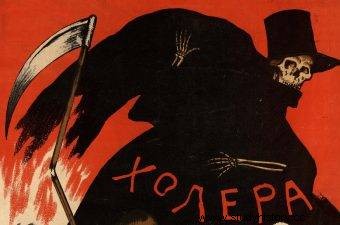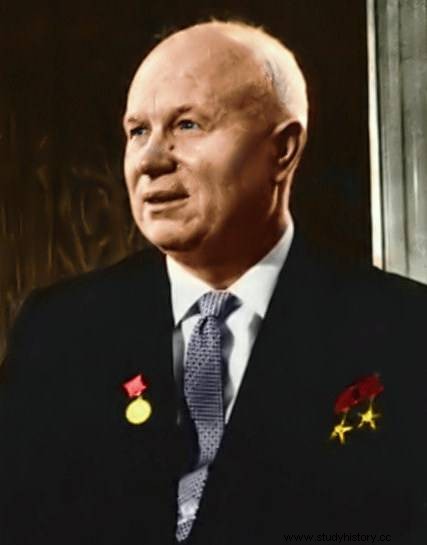In the Soviet Union, many infectious diseases were eradicated in the 1930s. Nevertheless, from time to time the country had to deal with epidemics "imported", brought from Asia or Africa by Soviet citizens. The methods of fighting dangerous microbes used by the then authorities were truly draconian ...
In the first years after the Bolshevik revolution, typhus was raging in the Soviet Union during the civil war. Hospitals lacked medicines, medical facilities were overcrowded, so very often patients were discharged immediately after their lives were no longer in danger. Therefore, patients from outside Moscow who fell ill in the capital, after leaving the ward, went ... straight to the station, where they continued to convalesce.

The USSR authorities had to struggle, inter alia, with cholera bouts.
There has also been a high incidence of influenza. Its spread was fostered by breaking the basic rules of hygiene. But Soviet citizens - mostly illiterate - were unaware of this. A series of information campaigns to raise awareness of the role of hygiene in everyday life had to be carried out.
An ingenious campaign
One of them took place during the flu epidemic in 1926–1927. The first wave of the disease swept across the country in the winter of 1926. Official figures say that in Moscow alone, 12,000 people suffered from the flu. people per week. In spring and summer, the authorities and medical services prepared for the next wave of the epidemic, including by adding thousands of extra beds, developing new rules of patient care and preparing cars for transporting patients.
In addition, hundreds of thousands of leaflets were printed explaining that flu "is transmitted by kissing, splashing saliva and sputum when coughing, sneezing and spitting, (...) sharing dishes and towels, shaking hands and sleeping with several people on the same bed" . It was advised to cover the nose and mouth with a tissue when sneezing and coughing, "do not spit sunflower seeds on the floor", wash hands and face thoroughly after returning home, boil the patients' underwear and ventilate the room.
People who were illiterate were approached in a different way. The so-called "sanitary propaganda trains" with colorful posters ran across the country. Teachers traveled in the carriages who gave lectures in community centers and clubs, and talked with citizens about cleanliness and hygiene.

Since many citizens could not read or write, posters were also used to combat epidemics.
To encourage students to listen carefully to these lessons, quizzes were organized after the class to test the acquired knowledge. Here are some examples of questions asked to participants:What should I do after using the toilet? Why should each family member have their own towel?
The winners were given a bar of soap, books and tooth powder. Joking songs were also sung called czastuszki:"This is a bad communist, who does not wash and is not clean." The actions were successful and the second wave was much milder than the first.
Black pox in Moscow
However, the flu was not the only challenge for the authorities and doctors in the USSR. They also had to contend with a more dangerous opponent - smallpox. One of the most dangerous episodes of this disease took place in the capital of the USSR at the turn of 1959 and 1960 - then 45 Muscovians fell on it.
Patient zero was the famous painter, 53-year-old Alexei Kokoriekin. On December 21, 1959, the man returned from India, where he witnessed the burning ceremony of a brahmana who had said goodbye to the world because of smallpox. In memory of this event, he bought a rug that belonged to the deceased. Two days after his return, Kokoriekin felt worse:he was diagnosed with the flu at the clinic and recommended bed rest.
But the artist's condition was deteriorating, so the ambulance took him to the Botkinsky Hospital, where he died on the evening of December 29. During the autopsy, the pathologist was unable to determine the cause of death, because in the USSR there had been no case of black pox for 30 years. An experienced 75-year-old doctor who arrived on January 13, 1960 was summoned. It only took one look at the body to make a correct diagnosis.
The KGB, the Ministry of Health and the Ministry of the Interior were immediately put on alert. Nikita Khrushchev, Secretary General of the Central Committee of the CPSU, was informed about the epidemiological threat. Botkin Hospital was quarantined:no one was allowed to enter or leave the premises.

Nikita Khrushchev, Secretary General of the Central Committee of the CPSU, was informed about the epidemiological threat.
All contacts of the deceased have been traced. As there was an excellent system of controlling citizens in the Soviet Union, nearly 10,000 people were identified within a week. They were passengers and the staff of the plane on which Kokoriekin was flying, customs and border guards at the Moscow airport, friends whom the artist visited after his return, and even salesmen from the commission shop where the man had left Indian souvenirs. On top of that, there were members of their families, friends, colleagues ...
Those who contacted Kokoriekin directly were placed in hospitals. The rest were placed under home quarantine and were visited by doctors twice a day. When it turned out that one of the Indian cruise passengers had left Moscow for Paris, the plane was turned back.
But it doesn't stop there! Entry and exit roads to Moscow were blocked, trains and flights were canceled. Vaccination of Muscovites and residents of the Moscow region against the killer disease has begun. About 30,000 medics were involved in the operation, including students of the capital's universities. In just 10 days, from January 15th to January 25th, 10 million people were vaccinated :over 5.5 million Muscovites and over 4 million inhabitants of the Moscow Oblast.
Quick and decisive action had the desired effect. Only 3 out of 45 patients died. The last patient was diagnosed on February 3, 1960. We managed to stop the spread of the dangerous microbe and save the country from an epidemic.
Find out more:Drinking urine, living in the gutter and other surprising methods to save yourself from an epidemic
The army is fighting cholera
The Russians were also hit by cholera. The first cases of the disease were recorded in early August 1970 in Batumi; more appeared in Astrakhan, where 537 people were hospitalized. Then cholera was registered in Saratov, Tiraspol, Volgograd, Novorossiysk, Kirov.
The most problematic was the situation in Odessa and Kerch, where people began to die. August was a vacation month, so there were thousands of Soviet citizens at the seaside. It was decided to evacuate them from these two cities, but they had to be quarantined before they left. For this purpose, 19 passenger ships moored in the local ports. After a period of forced isolation, 50,000 people returned to their homes. people.
But the departure of vacationers by no means helped to combat the epidemic. One day in Kerch there were as many as 1,520 new cases of cholera! That is why the authorities decided to cut off both places from the world - no one could leave these cities or enter them.
9,400 soldiers, 22 helicopters and 26 ships were involved in blocking Kerch. The exit roads from Odessa were patrolled by 5,000 uniformed, 9 ships and 5 helicopters. The fight against the disease was also attended by, inter alia, 2,500 medics and 7,500 Red Cross volunteers who referred people who showed symptoms to infectious diseases hospitals.
Of course, not all residents of Odessa and Kerch adhered to these restrictions. Panicked people wanted to get out of the sanitary cordon Therefore, the more enterprising citizens developed an illegal business - the transport of refugees on boats. Nevertheless, the draconian methods of fighting proved effective and in mid-September 1970 the disease was eradicated. Only 1% of patients died.
Bibliography:
1. Филимонов А., Чума, холера, черная оспа… "Версия" от 23.03. 2020.
2. Курганов Д., Cекретный карантин:Самые опасные эпидемии в России.
3. Анпилогов А., Полвека назад СССР уже победил одну эпидемию. "Взгляд", April 13, 2020.
